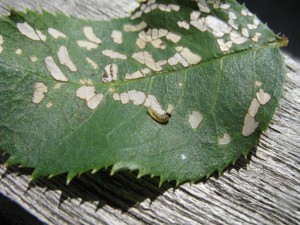
(C) Jo Ellen Meyers Sharp
Pansies, Johnny jump-ups and violas love the cooler weather and right now, they are beautiful. But fewer than 5 feet from these spring bloomers site more than 100 annuals, perennials, roses and shrubs for their trials in my garden this year.
The dilemma is when to pitch the pansies and replant pots with the new stuff. Many gardeners have this issue even with no plants to trial. Their new plants come from trips to the garden centers.
I’ve already started filling the hanging baskets or other pots that I pulled plants from last fall. Other pots contain tropical plants, such as Crinum, rain lily (Zephyranthes) and possibly one of the new lily of the Nile (Agapanthus). These wintered over on the enclosed, but unheated porch or in the basement.
Soon, I’ll transplant the Johnny jump-ups (Viola tricolor) and viola (V. cornuta) to a spot in the yard and compost the pansies (V wittrockiana).
Rose slugs
Seemingly overnight, rose leaves developed what’s called a stained-glass window look. A tiny caterpillar munches just enough green tissue to give rose leaves an opaque look.
The critter is commonly called a rose slug, although it is not a slug at all. It is the larvae stage of two or three sawflies. The sawfly lays eggs on the under side of rose leaves in early spring. As the eggs hatch and the caterpillars emerge, they feed on the leaves.
The best defense is a good offense. Every few days examine your roses, especially the under sides of leaves, for eggs. Use a strong spray from the hose to wash them away. Beneficial parasitic wasps like these insects, so Mother Nature will catch up with the problem if you avoid using pesticides.
If the infestation is severe, insecticidal soap and neem oil may work. Always read and follow the label directions.
